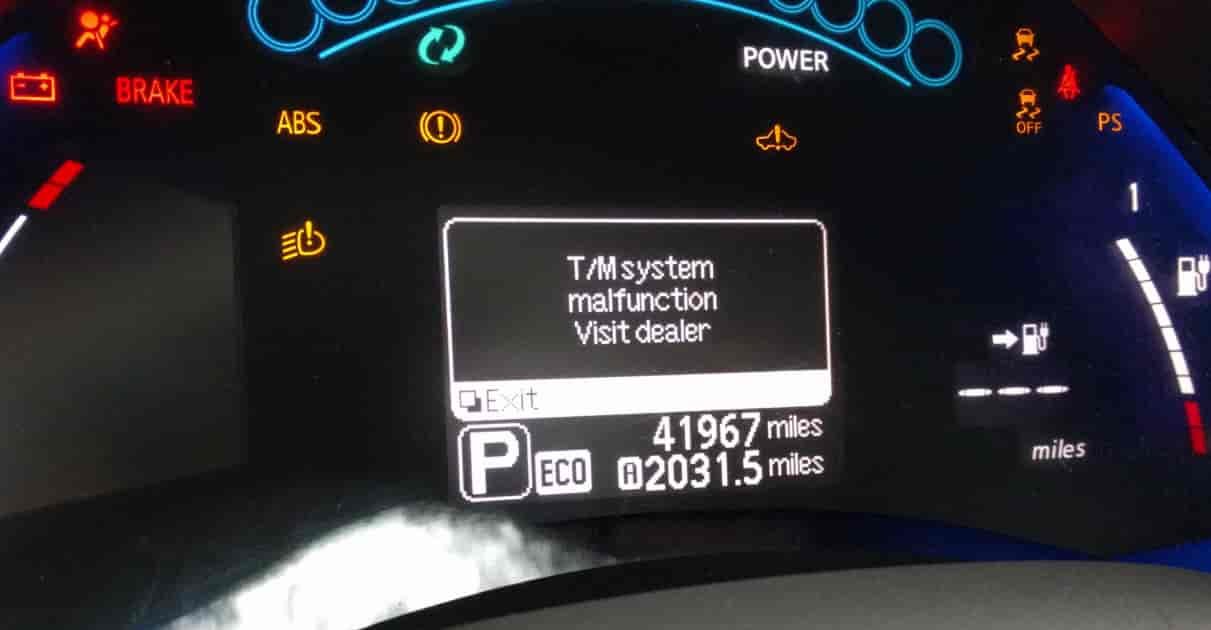Imagine starting your Nissan Leaf on a regular morning only to see a bright warning that says “T/M System Malfunction” on the dashboard. The car refuses to go into Drive or Reverse, and your heart skips a beat as you wonder if something major has failed. For many Leaf owners, this warning appears suddenly and disappears just as mysteriously, creating confusion and frustration.
The “T/M System Malfunction” message does not always mean your transmission is damaged. In most cases, it points to an electrical or voltage issue, often related to the 12-volt battery or the DC-DC converter that powers your vehicle’s control modules. When voltage drops too low, the Leaf’s sensitive systems miscommunicate and trigger the malfunction alert.
In this guide, we will break down what this warning really means, how to diagnose the root cause, and practical ways to fix and prevent it from happening again. Whether you are a first-time EV owner or an experienced Leaf driver, understanding this issue will help you stay calm, save money, and keep your car running smoothly.
What Does “T/M System Malfunction” Mean on a Nissan Leaf?
When the message “T/M System Malfunction” appears on a Nissan Leaf, it can sound alarming, as most drivers assume it refers to a transmission problem. However, in the Leaf, this warning rarely indicates a mechanical failure. The abbreviation “T/M” refers to the vehicle’s transmission management system, but in reality, the alert is triggered by the car’s electrical control modules when they detect abnormal voltage or communication errors.
The Nissan Leaf relies on a 12-volt auxiliary battery to power critical systems such as the computer modules, shifter logic, sensors, and dashboard. If this battery becomes weak, or if the voltage supply fluctuates, the vehicle’s control units can lose synchronization and mistakenly interpret it as a transmission malfunction. This leads to the warning message and can prevent the car from shifting into Drive or Reverse.
In other cases, the malfunction can occur due to a faulty DC-DC converter that charges the 12-volt system from the high-voltage traction battery. When this converter fails or produces unstable current, the Leaf may log error codes and display the “T/M System Malfunction” alert.
Understanding this relationship between electrical health and system communication is the key to diagnosing the issue correctly.
Most Common Causes of the T/M System Malfunction
In most Nissan Leaf vehicles, the “T/M System Malfunction” warning is not a sign of major transmission failure but rather a symptom of an electrical imbalance. Based on data from real owners and EV specialists, several recurring causes can trigger this message. Understanding each one helps you fix the issue faster and avoid unnecessary repairs.
Weak or Dead 12V Battery
This is by far the most common cause. The 12-volt battery powers all control modules when the car is off and helps initialize them during startup. If its voltage drops below normal levels, even temporarily, the Leaf’s communication systems can misfire, triggering the T/M malfunction message. Recharging or replacing the 12V battery often clears the error immediately.
DC-DC Converter Failure
The DC-DC converter is responsible for charging the 12V battery from the high-voltage traction pack. If it malfunctions, the 12V battery stops receiving proper charge and quickly loses voltage, leading to multiple system errors, including the T/M warning.
Corroded or Loose Electrical Connections
Moisture, corrosion, or loose ground points can interrupt voltage flow to critical modules. Even a small resistance in the circuit can confuse sensors and generate false warnings. Regular inspection of connectors and grounding points can prevent this.
Software or Communication Errors
Sometimes, outdated firmware or temporary glitches in the control modules can cause communication failures between subsystems. A simple reset or software update from the dealership can solve it.
True Transmission Control Module Fault
Though rare, an actual failure in the transmission control module or related sensors can cause persistent warnings that do not disappear after battery or voltage repairs. In such cases, diagnostic tools like LeafSpy or an OBD2 scanner are needed to read exact error codes before replacing any parts.
How to Diagnose the Problem
Before replacing any parts, it is important to diagnose the exact cause of the “T/M System Malfunction” warning. Many drivers spend money on unnecessary repairs when the real problem is simply a weak 12-volt battery. The following steps will help you identify the issue accurately and safely.
Step 1: Check the 12V Battery Voltage
Use a digital multimeter to measure the voltage at the battery terminals. When the car is off, a healthy reading should be around 12.6 volts. If it drops below 12.0 volts, the battery is weak. When the Leaf is in Ready mode, voltage should rise to about 13.5 to 14.5 volts, showing that the DC-DC converter is charging properly. If the voltage does not increase, the converter may be faulty.
Step 2: Inspect Battery Terminals and Ground Points
Corrosion or loose connections at the battery terminals can interrupt current flow and confuse the control modules. Clean any corrosion using a battery brush and ensure all connections are tight. Also, check the grounding cables connected to the chassis.
Step 3: Use LeafSpy or an OBD2 Scanner
Connect an OBD2 scanner or the LeafSpy app to read diagnostic trouble codes (DTCs). These codes will tell you whether the fault is electrical, communication-related, or linked to the transmission control unit. Record the codes before clearing them, as they help identify patterns in the malfunction.
Step 4: Try a System Reset
After checking the 12V battery, disconnect it for five to ten minutes, then reconnect and start the car. This simple reset can clear temporary errors if they were caused by low voltage or communication lag.
Step 5: Observe the Dashboard and Driving Behavior
If the warning disappears after recharging or replacing the 12V battery, the issue is likely voltage-related. If the error returns or the car refuses to go into Drive or Reverse, further inspection of the DC-DC converter or transmission control module is necessary.
By following these diagnostic steps, you can identify the source of the malfunction with confidence and avoid costly misdiagnoses.
How to Fix the T/M System Malfunction
Fixing the “T/M System Malfunction” in a Nissan Leaf is usually simple once the cause has been identified. In most cases, the issue comes from unstable voltage or a faulty charging component. The first step is to check the 12-volt battery, as low voltage is the most common cause of this warning.
If the reading is below twelve volts, recharge the battery using a smart charger until it reaches about twelve point six volts. When the battery is more than four years old or can no longer hold a charge, replacement is the best option. A new battery often clears the malfunction message immediately and restores normal performance.
After recharging or replacing the battery, disconnect it for around five minutes before reconnecting. This reset allows the vehicle’s control modules to recalibrate. When the car is turned on again, the warning should disappear if the voltage problem has been fixed. Avoid using quick code-clearing tools before addressing the cause, as the error may return.
It is also important to check the main electrical connectors related to the transmission control and DC-DC converter. Look for corrosion, moisture, or loose pins that can interrupt voltage flow. Clean them gently with contact cleaner and make sure they are reattached securely. Poor electrical contact can cause intermittent malfunctions or false system errors.
By restoring stable voltage, cleaning connectors, and following proper maintenance, you can safely eliminate the “T/M System Malfunction” warning and return your Nissan Leaf to full operation without the need for costly repairs.
When to Seek Professional Help
While many “T/M System Malfunction” warnings can be fixed by recharging or replacing the 12-volt battery, there are times when professional diagnosis is necessary. Ignoring persistent alerts or forcing the car to operate while the malfunction remains active can cause more serious electrical or control system failures.
If the warning reappears even after installing a new and fully charged battery, the issue may come from the DC-DC converter or the transmission control system. These components handle complex power distribution and require specialized diagnostic tools to test accurately. Attempting to repair them without proper equipment may lead to further complications.
Another clear sign that professional help is needed is when the car refuses to start or shift into Drive or Reverse. Repeatedly restarting the vehicle under these conditions can place additional stress on the system. Instead, it is best to contact a certified EV technician who can safely inspect the communication modules and voltage regulators using high-voltage diagnostic instruments.
Electrical damage is another situation that demands expert attention. If you notice melted fuses, a burnt odor, or visible corrosion in the connectors, the problem could involve overheating or short circuits. Handling these components without the right safety training can be dangerous and may worsen the issue.
In some cases, an outdated software version can also trigger persistent malfunctions. Visiting an authorized Nissan service center for a software or firmware update ensures that the car’s modules communicate correctly. Certified technicians have the latest tools to reprogram the system and permanently clear stored error codes.
Seeking professional help at the right time ensures accurate repairs, prevents unnecessary part replacements, and helps you avoid costly breakdowns in the future.
Conclusion
The “T/M System Malfunction” warning in the Nissan Leaf often looks alarming, but in most cases it is not a sign of serious transmission failure. Instead, it is a signal that your car’s electrical system-especially the 12V battery or DC-DC converter-is struggling to maintain stable voltage. By understanding how these components work together, you can fix the issue quickly and prevent it from returning.
Most owners discover that replacing or recharging the 12V battery instantly clears the warning and restores normal performance. Regularly checking voltage levels, cleaning connectors, and using approved charging equipment are simple habits that keep your Leaf running smoothly. For more complex issues such as converter failure or persistent error codes, a qualified EV technician or Nissan service center can provide professional support.
Caring for your Leaf’s electrical health is one of the easiest ways to ensure long-term reliability and peace of mind. The next time you see the “T/M System Malfunction” alert, do not panic-check your battery first, follow the steps in this guide, and your car will likely be back to normal in no time.
Have you ever experienced this malfunction with your Nissan Leaf? Share your story and what worked for you in the comments.

